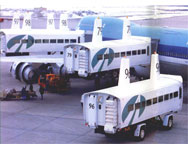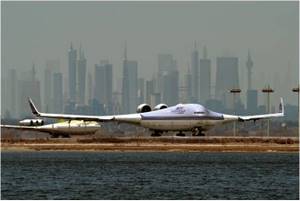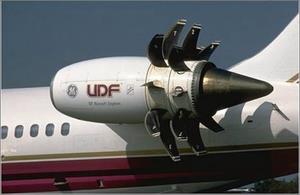Aviation is a very carbon-intensive transport mode. Without readily available technological solutions to its carbon intensity and with fleet renewal lead-in times averaging 30 years, Andrés Drew, BCL/LLB’07, imagines one possible climate and socio-economic scenario among many: a world fifty years hence that has not achieved carbon-free flight and is dealing with the consequences.
Departure: Wimbledon
I don’t remember consistently waking up in a sweat during Wimbledon summers. Londoners who live in these parts know when to leave the city and no better time than during the lawn tennis Championships, when the village and high streets are full of European tourists arriving by high-speed rail. North Americans used to flock to SW19 for two weeks in June-July, but climate change has made Grand Slam tennis tourism unaffordable. Next year, the Championships will be moved to spring when the temperature is milder and the grass actually green. We are living in a carbon-constrained world and even elite tennis needs to adapt to the changing climate.
Flight Plans
This is a special day. I have rationed my annual two-ton carbon allowances for five years and accumulated enough savings to offset the remaining emissions for a return flight to Montreal. There is nothing in my suitcase but beach-wear, which is convenient since the weight allowance is 10Kg for all baggage and Montreal will be seven degrees warmer than London: a balmy 40 degrees Celsius.
I booked my flight three weeks ago: not specifying any particular airline or airport and instead of choosing a specific departure time and date, I indicated a 48-hour departure window. This lottery feature of modern aviation helps increase load factors (i.e., lower passenger carbon intensity) and results from new business models that require information sharing among carriers. It also cuts costs significantly.
I got lucky – yesterday an email confirmed my morning flight and departure airport: Heathrow.

My aircraft will be operated by Emirates and because I live close enough to Heathrow to travel by Tube, I will go through check-in as well as security at Paddington or Victoria train stations as part of a measure intended to reduce congestion at airports.
The roller-suitcase that I drag down Wimbledon Hill Road is louder than the electric cars and buses going by. I touch my integrated Oyster and Carbon Budget (OCB) card at the Tube gates to board the District Line for Heathrow. Maybe a taxi would have been a better option, but governments and airports provide serious incentives to take trains because the British Courts have interpreted the scoping requirements for airport carbon footprints to include ground transport access services. No point in even thinking about going by car since they closed all car parks at U.K. airports.
.
Heathrow
My arrival at Heathrow confirms media reports that aviation has lost its luster. I’m flying out of Terminal Six, which is the newest and was built in 2017 before the world got serious about capping aviation growth in the absence of a technological solution.
I can’t help but put a twist on the famous line from the movie Field of Dreams: “If you build it they will not come.” Check in is uneventful; there is barely a queue. The Mirabel-esque emptiness reinforces the futility of ongoing debates among aviation analysts over which idea was worse: expanding Heathrow by building Terminal Six, or proceeding with the Thames Estuary offshore airport project to build an island in the middle of the Thames and perch an airport on top.

In reality, both were bad ideas and while the Terminal Six expansion cost less, neither fully took account of climate change impacts on the aviation industry. Indeed, the sea-level rises and storm surges now afflicting the East coast of the UK could have been modeled to demonstrate that the offshore airport project was indeed nonsense on stilts—good thing it was never built.
At the boarding call, we are encouraged to use airport bathroom facilities and fill up personal water-bottles, not as a green marketing strategy to promote the water re-use system, but to avoid unnecessary weight on-board to reduce fuel consumption. I also receive my second reminder of Mirabel: from the terminal, there are no passenger-loading bridges or aircraft in sight. Instead of being herded into jetways, we are now shepherded onto electric Passenger Transfer Vehicles (PTVs) that bus us to the tarmac area where our plane awaits.
As the PTV turns onto the ramp, the vehicle’s glass windows provide a beautiful view of the terminal building, the 21st century’s answer to cathedrals, equipped with solar panels and wind turbines to achieve carbon neutrality.
Aircraft

When the aircraft comes into view, my initial thoughts run along the lines of: Star Wars meets Howard Hughes. The plane sports enormous open rotor propellers and the airframe looks more like an oversized stealth bomber with laminar flow wings than a long-haul passenger plane.
The smell is also different, with no scent of burning kerosene to greet me as I prepare to board. To economize on carbon and improve local air quality, engines are turned off while the plane is on the ramp. Instead of using an auxiliary power unit, the instruments and cabin are powered by electricity. The aircraft is even taxied onto the runway by an electric tug.
The interior of the plane reminds me of an early 21st century Greek high-speed ferry. Minimalism is ubiquitous here as unnecessary weight (baggage, in-flight entertainment, duty-free) is the enemy of low carbon operations. Five rows of eight seats in a line, at its widest, a guesstimate of 700 passengers and it doesn’t look like one will be empty. Today, aircraft operations are only profitable when the aircraft is completely full. Because passengers must pay a hefty supplement to compensate for empty seats, air travel customers have become more flexible in their flight planning, especially in their willingness to compromise on when they fly and what airports they fly from.
Transatlantic flying has returned to what it was in the 1950s, a rare and costly experience. The small first-class section is now reserved for the very rich while business executives, many celebrities and average individuals fortunate enough to afford a ticket and carbon offsets fly economy class—private jets are a thing of the past.
Flight

As I settle into my seat and prepare for take-off, it is business as usual until the open rotor engines are switched on. If it’s noisy in the cabin, I wonder what local residents think? The distinct aroma of alga biodiesel slowly seeps into the cabin. My trance from the loud humming noise is interrupted by the captain’s voice informing us that we will shortly be taking-off and attempting a continuous ascent in order to reduce the environmental impact (noise and carbon).
Take-off is longer than usual but after a 15-minute three-degree angle of ascent, we are cruising at 25,000 feet. According to the in-flight pilot environmental brief, this lower altitude removes the risks of the aircraft generating contrails (condensation trails of water vapor), a result that would otherwise multiply aviation’s warming impact on the climate.
The direct flight to Montreal takes nine hours. This new fleet of aircraft compensates for the extra fuel burn at lower altitudes (caused by the higher density of air) with a lower optimal flight speed. Adding to the total journey length is that optimal flight routes to Montreal have incrementally moved further North to avoid the headwind of a climate change induced pole-ward shift in the jet stream.
With no in-flight entertainment and minimalist meals, I settle into Ian McEwan’s classic, Solar, followed by a very long nap, partly induced by the aircraft that sounds like a Cessna destined for the Canadian wilderness. Good thing they provide ear plugs.
Trudeau Airport

Upon arrival and after the carbon allowance retina scan, I inspect my surroundings. Lifestyles have changed in the U.K., but surely not as dramatically as in Canada, which has had the herculean task of reducing per capita carbon emissions from 25 tons in 2010 to 2 tons today.
Trudeau Airport seems more snug and busier, perhaps because it has not expanded for 35 years. One welcome change is the frequent rail connection to Gare Centrale and the West Island, which they finally built in 2030. They have turned the airport into an inter-modal transport hub for commuters, which may be a possible explanation for the bustling surroundings.
The commuter train platforms are ultra-modern, as are the rolling stock. Best of all the live train information indicates a service every ten minutes. As the doors slide open, I roll my suitcase onto the carriage and comfortably stand by the window just before the wide gangway between the air-conditioned cars surrounded by men and women in business attire.
Arrival: Pointe-Claire
The short journey from the airport to home is a window on the significant lifestyle changes in Canada. Small vehicles and the clutter of buses, once symbolic of European or Japanese geographic and demographic constraints, are here too now. Where there were once gas stations there are now eco-homes or emergency electric charging facilities for vehicles. The wide highways all have designated bus lanes as do the large boulevards that shape the West-Island’s transport system. Milder winters have made viable the creation of cycle paths along most major roads, although it’s too hot for most to consider cycling other than a few blocks from the train station this summer.
One word comes to mind to describe my world in 2050: convergence. But for the extreme heat and humidity, lifestyles in the West Island are much like in Wimbledon.
Andrés Jonathan Drew B.A., LL.B., B.C.L. (McGill),M.Sc. (LSE) is a researcher in the Department of Law at the London School of Economics and the Met Office Hadley Center. Previously, he was a research associate at Project OMEGA & the Center for Air Transport and the Environment at Manchester Metropolitan University. The author is very grateful to Professor Callum Thomas for helpful comments on the scientific and technical aspects of this article.
